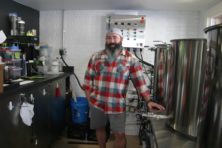Suds with Sophie: Brewing Ingredients, Part 6
- Share
- Tweet
- Pin
- Share
Yeast, Part 1
by Sophie Nelson
The final ingredient in beer – yeast – was essential but unknown even as recently as the 1500s, although beer had been made since at least 5000 B.C. In 1516, the Reinheitsgebot Beer Purity Law, introduced in Bavaria, limited the ingredients that could be used to make beer to water, barley (malts) and hops.
That’s right: The fourth ingredient, yeast, was not understood well enough to be included in the original list. Of course, early brewers knew something was happening during the fermentation period, but they didn’t understand completely how or what was happening.
Yeast works its magic during one of the final brewing steps, and it’s so important that only after that stage can the liquid be called beer. Before that phase, it’s simply wort: the sweet liquid produced when milled malted barley is combined with hot water to release sugars.
Fermentation – the process during which yeast is added – requires a few steps that involve lots of recording, temperature adjusting and monitoring. The main thing that’s taking place during fermentation is the development of alcohol.
Speaking in brewing terms, the yeast metabolizes the sugars in the wort and produces ethanol, carbon dioxide and a small amount of a few other chemicals. Yeast first metabolizes simple sugars in a wildly violent process (lots of bubbles), and then it moves on to more complex sugars. The longer yeast is allowed to metabolize sugars, the drier and more alcoholic the beer will be. Brewers monitor this process so that yeast ferments only to a certain point; then the rest of the sugars (called residual sugars) remain in the beer for body, sweetness and flavor. High-alcohol beers that are also quite sweet, therefore, start out with more sugars than sweet, low-alcohol beers or dry, high-alcohol beers.
Yeast today is much better understood, and it’s still highly respected. In fact, a common saying among brewers and beer lovers is that “brewers make wort, but yeast makes beer.” Brewers choose the types and amount of malts; the length of the boil; the timing, amount and types of hops to add; and the type of yeast that will best suit the beer, but when it comes to the fermentation process, all they can do is make their chosen yeast happy so that it will ferment the beer as they intend.
One of my favorite beer stories is about early Belgian brewers who were living in the countryside. Some wealthy farmers maintained a separate brewhouse in order to make low-gravity – that is, low-alcohol and light-bodied – table beers for meals.
These little brewhouses were made of wood, so they burned down often. Of course, the farmers could simply rebuild their brewhouses with new wood, but they knew that the magic process that turned their sweet wort into beer would not occur.
This was because the strain of bacteria yeast used to make the beer lived in the wood. Whether the farmers understood this or not, they definitely knew that new wood would not make beer – or at least not for a few years. Therefore, when a brewhouse burned down, a neighboring farmer would donate a few panels of wood from his brewhouse to be used in building the new one.

